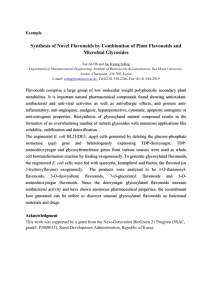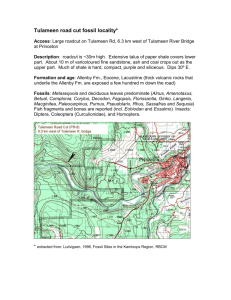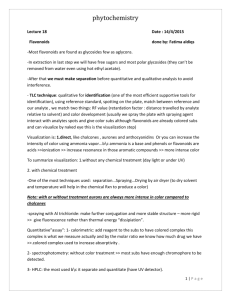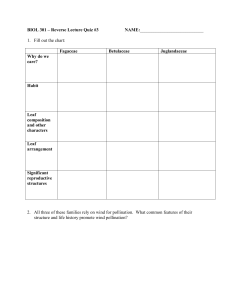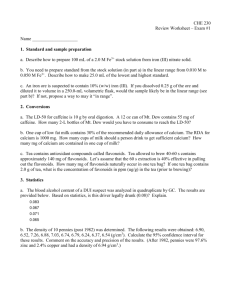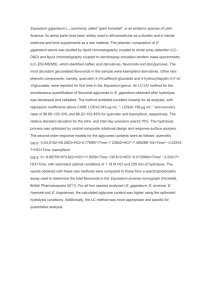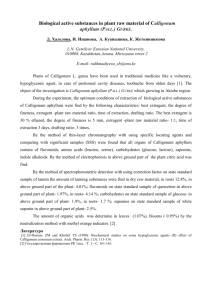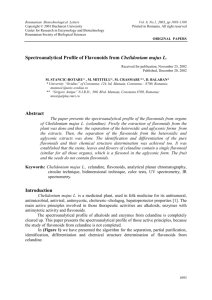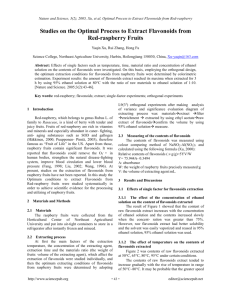Full Article
advertisement
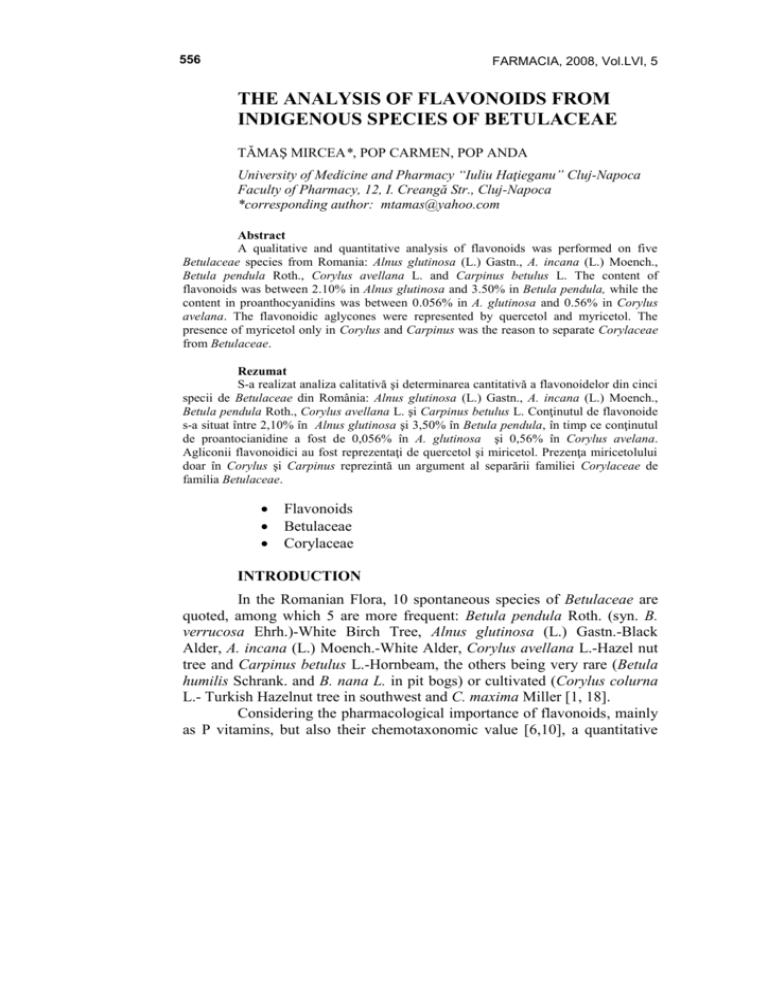
556 FARMACIA, 2008, Vol.LVI, 5 THE ANALYSIS OF FLAVONOIDS FROM INDIGENOUS SPECIES OF BETULACEAE TĂMAŞ MIRCEA*, POP CARMEN, POP ANDA University of Medicine and Pharmacy “Iuliu Haţieganu” Cluj-Napoca Faculty of Pharmacy, 12, I. Creangă Str., Cluj-Napoca *corresponding author: mtamas@yahoo.com Abstract A qualitative and quantitative analysis of flavonoids was performed on five Betulaceae species from Romania: Alnus glutinosa (L.) Gastn., A. incana (L.) Moench., Betula pendula Roth., Corylus avellana L. and Carpinus betulus L. The content of flavonoids was between 2.10% in Alnus glutinosa and 3.50% in Betula pendula, while the content in proanthocyanidins was between 0.056% in A. glutinosa and 0.56% in Corylus avelana. The flavonoidic aglycones were represented by quercetol and myricetol. The presence of myricetol only in Corylus and Carpinus was the reason to separate Corylaceae from Betulaceae. Rezumat S-a realizat analiza calitativă şi determinarea cantitativă a flavonoidelor din cinci specii de Betulaceae din România: Alnus glutinosa (L.) Gastn., A. incana (L.) Moench., Betula pendula Roth., Corylus avellana L. şi Carpinus betulus L. Conţinutul de flavonoide s-a situat între 2,10% în Alnus glutinosa şi 3,50% în Betula pendula, în timp ce conţinutul de proantocianidine a fost de 0,056% în A. glutinosa şi 0,56% în Corylus avelana. Agliconii flavonoidici au fost reprezentaţi de quercetol şi miricetol. Prezenţa miricetolului doar în Corylus şi Carpinus reprezintă un argument al separării familiei Corylaceae de familia Betulaceae. Flavonoids Betulaceae Corylaceae INTRODUCTION In the Romanian Flora, 10 spontaneous species of Betulaceae are quoted, among which 5 are more frequent: Betula pendula Roth. (syn. B. verrucosa Ehrh.)-White Birch Tree, Alnus glutinosa (L.) Gastn.-Black Alder, A. incana (L.) Moench.-White Alder, Corylus avellana L.-Hazel nut tree and Carpinus betulus L.-Hornbeam, the others being very rare (Betula humilis Schrank. and B. nana L. in pit bogs) or cultivated (Corylus colurna L.- Turkish Hazelnut tree in southwest and C. maxima Miller [1, 18]. Considering the pharmacological importance of flavonoids, mainly as P vitamins, but also their chemotaxonomic value [6,10], a quantitative FARMACIA, 2008, Vol.LVI, 5 557 analysis of the flavonoids from the leaves of indigenous Betulaceae species, but a also a qualitative one in order to define the position of the genera in this family, was considered useful. In this context, recently the Betulaceae family was divided in two families: Betulaceae with Betula and Alnus genera and Corylaceae with Corylus and Carpinus [1]. For pharmaceutical purposes, Betulae folium-birch leaves are used for their diuretic properties while Coryli folium-hazelnut tree leaves are used for their venotonic, anti-inflammatory and wound-healing properties [5, 9]. Hegnauer [6] and Wichtl [14] quote the following classes of active principles in Betulaceae leaves: polyphenols (flavonoids, tanins, phenylpropanoid compounds of caffeic acid type), saponins, triterpenes (betuloside, betulinic acid), monotropeoside (a methyl-salycilate heteroside) and essential oil. The European Pharmacopoeia stipulates a minimal content of flavonoids of 1.5%, expressed in hyperoside in Betulae folium [17]. Dallenbach-Tolke et al. [3] had identified 7 flavonoid glycosides, mainly those of quercetol (hyperoside and isoquercetrin), and also Elbanowska [4] had determined a 2.10% content of flavonoid of which hyperoside represents over 77%. In Romania, flavonoids from birch and hazel nut tree leaves were studied by Ilea et al. [8] and Csedö C. et al. [2]. Several homeopathic products are prepared from the foliar buds of Alnus (alder). MATERIALS AND METHOD The leaves from five species of Betulaceae (Table I) were harvested from the wild flora of Cluj County (Ciucea) in early august 2006. The leaves detached from the branches were dried at room temperature in the shadow, then grinded to a fine powder (VIth sieve, Romanian Pharmacopoeia). The qualitative analysis of the flavonoids was performed by thyn layer chromatography (TLC) in the following experimental conditions: Stationary Phase: Silica gel G (Merck), ready-made plates 10x20 cm Mobile phase: ethyl-acetate:water:formic acid:acetic acid (72:14:7:7) The samples: were obtained from 0.5 g vegetal powder which was extracted with 10 ml methanol on a boiling water bath for 30 minutes in a round flask with ascending condenser. Standard substances: rutoside, hiperoside, quercitroside 0,1% in methanol, caffeic acid, chlorogenic acid 0,1% in methanol (C. Roth) Aliquots: 10 μl from the samples and 5 μl from the standard substances in liniar spots of 10x3 mm. 558 FARMACIA, 2008, Vol.LVI, 5 Migration distance: 7,5 cm Identification: Neu-PEG Reagent, examination in UV at 365 nm [15, 17]. For the qualitative analysis of the flavonoidic aglycones, 5 ml from the five samples were treated with 10 ml HCl 2N in a flask with ascending condenser for 40 minutes on a boiling water bath. After cooling, the solution was twice extracted with 10 ml ethyl-acetate in a separation funnel. The reunited solutions were washed with water to remove acid traces and then passed over anhydrous sodium sulphate. Then, they were completely evaporated, the residue being disolved in 2 ml methanol (aglycone sample). The qualitative analysis of the aglycones was performed by TLC in the following experimental conditions: Stationary phase: Silica gel G (Merck), readymade plates 10x20 cm Mobile phase: toluen:ethyl-acetate:formic acid (50:30:10) Standard substances: quercetin, miricetin, kempferol, apigenine and luteoline 0.1% methanolic solutions (C. Roth) Aliquots: 10 μl from the samples and 5 μl from the standard substances Identification: Neu-PEG Reagent, examination in UV-light at 365 nm and in daylight [15, 17]. The quantitative determination of the flavonoids from the five Betulaceae species was performed by the spectrophotometric technique indicated by Romanian Pharmacopoeia Xth Ed. (R. Ph. X) for Cynarae folium, using aluminium chloride as reagent and a calibration curve constructed with rutoside. For the determination of the total flavonoids we used 0.5% extractive solutions obtained with 50º ethanol on a boiling water bath in a flask with ascending condenser. The quantitative determination of proanthocyans was performed by the spectrophotometric technique of Lebreton [11], after the transformation of proanthocyans in anthocyans and their selective extraction with butanol [11]. For this purpose, 0.5 g vegetal powder was treated with 50 ml HCl 2N in a round flask with ascending condenser and was kept 40 minutes on a boiling water bath. After cooling, the solution was filtered and twice extracted with 20 ml n-butanol in a separation funnel. The butanolic solutions were reunited and diluted to 50 ml, and then the optical density (absorbance) was determined at 550 nm. The content in proanthocyans was calculated with the equation: L%=0,052DOV/P, where DO is the absorbance of the butanolic solution at 550 nm, V- the volume of solution (50 ml) and P-the weight of the plant powder (0.5g). 559 FARMACIA, 2008, Vol.LVI, 5 RESULTS AND DISCUSSION From the chromatographic analysis for the flavonoidic glycosides (Fig. 1) it is obvious that these substances are well represented both quantitatively and qualitatively. With the Neu-PEG reagent, the flavonosides presented a yelloworange fluorescence and the phenyl-propanoid compounds a blue one. The number of fractions is different according to the species even in the same genus. 1 2 3 4 5 6 Figure 1 TLC analysis of the flavonoidic glycosides from the studied species 1-Alnus glutinosa, 2-A.incana, 3-Betula pendula, 4-Corylus avellana, 5-Carpinus betulus), 6-standard substances: rutoside, hyperoside, quercitoside, caffeic acid For example, in the leaves of Alnus glutinosa only 3 fractions were present in small quantities, while in A. incana 4 fractions were present, two being in a superior proportion to the first species. In Betula pendula 4 fractions were present among which hyperoside is predominant, being present also in A. incana. The flavonoids from Carpinus and Corylus were different from the ones in the first three species, the number of fractions being superior for Carpinus and also one of the fractions having the Rf value between hyperoside and quercitroside. In both species, quercitroside was present. Furthermore, chlorogenic acid was also present in these two species. The presence of the two aglycones was confirmed also by the examination of the chromatographic plate in daylight when a yellow-orange fluorescence is present. From the analysis of the aglycones separated by TLC (Fig. 2) one can see that quercetol was present in all species, but myricetol was present only in two species: Carpinus and Coryllus. 560 FARMACIA, 2008, Vol.LVI, 5 1 2 3 4 5 6 7 8 Figure 2 TLC analysis of the aglycones from the studied species (1-Carpinus betulus, 2Corylus avelana, 3-Alnus incana, 4-A. glutinosa, 5-Betula pendula, 6quercetol+kempferol, 7-myricetol, 8-chlorogenic acid) The presence of myricetol only in the two species which are now included in a distinct family-Corylaceae along with the taxonomic value of myricetol, considered a primitivism marker [6, 10] justifies the separation of the two genera (Carpinus and Corylus) in a distinct family. Total content of flavonoids is presented in Table I. The analysis of the results showed that all indigenous Betulaceae species contain a high percent of flavonoids in their leaves (over 2%), four of them having a content over 3%, the highest content being present in birch tree, hornbeam and white alder. The lower content of flavonoids present in the leaves of black alder can be explained by the preference of this tree for shady areas. No. 1. 2. 3. 4. 5. Species (folium) Alnus glutinosa A. incana Betula pendula Corylus avellana Carpinus betulus Table I Total content of flavonoids Content in flavonoids g% (in rutoside) 2.10 3.33 3.5 3.00 3.4 The content in proanthocyans expressed in procyanidine (g %) is presented in Table II. FARMACIA, 2008, Vol.LVI, 5 No. Species (folium) 1. 2. 3. 4. 5. Alnus glutinosa A. incana Betula pendula Corylus avellana Carpinus betulus 561 Table II Total content in proanthocyans Content in proanthocyans (g% in procyanidine) 0.056 0.077 0.480 0.560 0.180 The results showed that there are great differences among these species regarding the content of proanthocyans. Only two of the five studied species presented a high content of proanthocyans in their leaves: hazel nut tree (0.560%) and birch tree (0.480%). The hornbeam leaves presented a medium content of proanthocyans (0.180%) while the alder species showed a low content (under 0.1%). The high content of proanthocyans of birch and hazel nut trees increases their therapeutic value, this class of compounds being considered superior to other flavonoids as P vitamins. CONCLUSIONS - - The flavonoids from the leaves of 5 indigenous species were analyzed both qualitatively and quantitatively. The leaves from the indigenous Betulaceae species presented a high content of flavonoidic heterosydes (over 2%) with a maximal value of 3.50% for Betula pendula and 3.40% for Carpinus betulus. The content of proanthocyans is high for Corylus avellana (0.56%) and Betula pendula (0.48%). The most important flavonoidic aglycones, quercetol and myricetol have been identified by TLC. The presence of myricetol, a flavonol considered a marker for primitivism only in Corylus avellana and Carpinus betulus correlated with its absence in the other Betulaceae species is a biochemical evidence for the separation of the first two species in a distinct familyCorylaceae, postulated in recent classification systems. REFERENCES 1. Ciocârlan V.: Flora ilustrată a Romaniei, Ed. Ceres, Bucureşti, 2000, 189-192 562 FARMACIA, 2008, Vol.LVI, 5 2. Csedö C., Fülop L., Nuszl L.: Dermatological Effects of Extracts from Hazelnut leaves (Corylus avellana), Planta Medica, 1978, 32, 270-272 3. Dallenbach-Tölke K., Nyiredy S., Meier B., Sticher O.: HPLCAnalyse der Flavonoidglykoside and Betulae folium, Planta Medica, 1987, 2, 121-232 4. Elbanowska A., Kaczmarek F.: The flavonoids from Betulae folium, Herba Polonica, 1965, 11(1-2), 47-56 5. Grigorescu E., Lazăr M.I., Stănescu Ursula: Index fitoterapeutic, Ed. Cantes, Iaşi, 2001, 80-81, 160 6. Harborne J.B.: Comparative Biochemistry of Flavonoids, Acad. Press, London-New York, 1967 7. Hegnauer R.: Chemotaxonomie der Pflanzen, Bd.3, Birkhausser Verlag, Basel und Stuttgart, 1964, 255-268 8. Ilea Laurenţia, Tămaş M.: Cercetări asupra flavonoidelor din Betula verucosa, Farmacia, 1986, 34(1), 45-50 9. Istudor Viorica: Farmacognozie, Fitochimie, Fitoterapie, vol. I, Ed. Medicală, Bucureşti, 1998, 290, 318-321 10. Lebreton P.H.: Recherches chimiotaxonomique sur les plantes vasculaires (8), Naturalia Montpelliensis Soc. Bot., 1968, 19, 79-86 11. Lebreton P., Jay M., Voirin B.: Sur l'analyse qualitative et quantitative des flavonoides, Chim. Anal. Fr., 1967, 49, 375-383 12. Markham K.R.: Tecniques of Flavonoid identification, Acad. Press, London-New York, 1982, 15-35 13. Pitera F.: Compendiu de Gemoterapie Clinică, Ed.III, Genova, 2000, 141, 144 14. Wichtl M.: Herbal Drugs and Phytopharmaceuticals, Ed. Medpharm, Stuttgart, 1994, 106-108 15. York H., Funk W., Fischer W., Wimmer H.: Thin-Layer Chromatography, VCH Weinheim, 1990, 277-280 16. ***Farmacopeea Romană Ed. X, Ed. Medicală, Bucureşti, 1993, 334-335 17. ***European Pharmacopoeia, CE Strassbourg, 2008, 1311-1312 18. ***Flora Europaea vol. I, Cambridge Univ. Press, 1993, 68-71.
